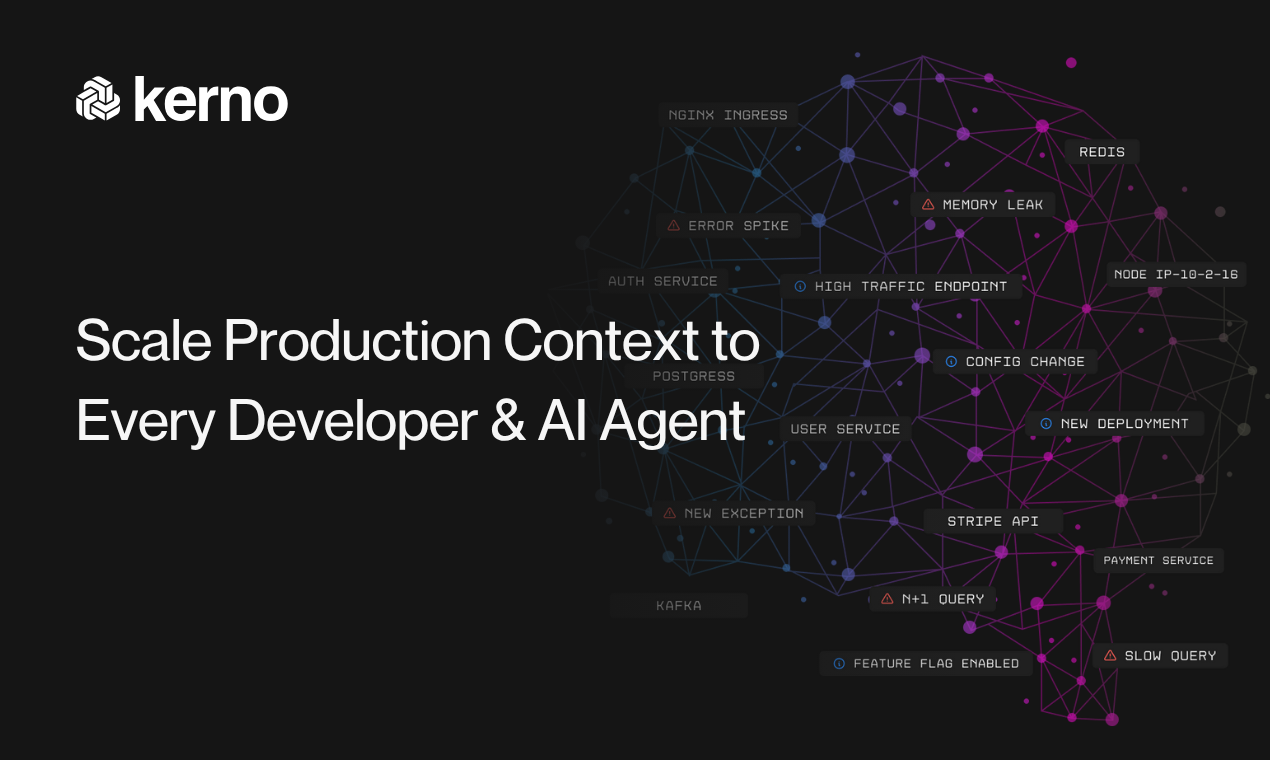Table of Contents
Overview
In today’s software development landscape, having immediate feedback from live systems and AI coding assistants is essential for maintaining speed and reliability. Kerno Core is a lightweight runtime intelligence engine that establishes a tight, bi-directional feedback loop among production environments, human developers, and AI code agents. By delivering real-time context directly into development workflows, it transforms how teams detect issues, optimize performance, and evolve their applications with confidence.
Key Features
Kerno Core offers a suite of capabilities designed to streamline development and uphold system stability:
- Lightweight runtime monitoring: Collects low-level metrics and traces via eBPF without requiring code changes, keeping CPU and memory overhead under 2 percent.
- Real-time telemetry: Streams live performance data—including API latencies, database query hotspots, and error rates—into the IDE and dashboard.
- AI-assisted debugging: Feeds contextual runtime information to AI code agents, enabling them to suggest precise fixes and reduce mean time to repair.
- Developer-AI collaboration: Integrates with VS Code, JetBrains IDEs, and popular AI assistants to let humans and machines work in concert on the same diagnostics and recommendations.
- Live system insights: Correlates events, traces, and logs across services to show end-to-end request flows and pinpoint failure domains instantly.
- Automated anomaly detection: Applies machine learning models to flag unusual performance deviations or error spikes before they impact users.
- Tight feedback loops: Delivers actionable alerts and code suggestions directly to pull requests, chatops channels, or IDE panels, closing the gap between issue detection and resolution.
How It Works
Kerno Core installs in minutes using a Helm chart or Kubernetes manifest—no SDKs or pipeline rewrites needed. An eBPF-based agent hooks into the Linux kernel to capture granular events across services, containers, and host nodes. This raw telemetry is streamed to Kerno Studio, where it’s aggregated, correlated, and visualized without storing sensitive payload data outside your cloud. Simultaneously, an IDE extension and API server surface this context to AI coding agents and developers, enabling on-the-fly performance tuning and guided debugging. As code changes roll out, Kerno learns system behaviors and continuously refines its anomaly detection and recommendation engines.
Use Cases
Kerno Core’s combination of real-time data and AI feedback proves valuable in:
- CI/CD Monitoring: Visualize deployment health, detect pipeline regressions instantly, and roll back changes before they reach production.
- Real-time Debugging: Identify the root cause of errors or performance bottlenecks in live environments without sifting through siloed dashboards.
- Production System Optimization: Continuously analyze resource hotspots and service dependencies to tune throughput and reduce costs.
- AI-Powered Root Cause Analysis: Leverage AI to correlate events across logs, metrics, and traces, automatically surfacing likely failure triggers.
- Proactive Health Management: Anticipate capacity issues and error trends by setting adaptive thresholds that evolve with system usage.
Pros \& Cons
Advantages
- Immediate visibility into live system behavior for faster decision-making
- Deep integration between human developers and AI agents, boosting collaboration
- Streamlined debugging workflows that cut down mean time to resolution
- Enhanced reliability through automated anomaly detection and adaptive alerts
- Zero code instrumentation and predictable, per-node pricing
Disadvantages
- Linux-only eBPF agent; Windows and non-Kubernetes environments are not supported yet
- Early-stage offering may lack niche enterprise controls such as advanced RBAC or audit logging
- Handling sensitive data on-cluster requires alignment with internal security policies
- Requires Kubernetes or container-orchestration familiarity for initial setup
How Does It Compare?
While several observability tools address monitoring and debugging, Kerno Core stands out by embedding runtime context directly into AI-assisted coding workflows:
- Honeycomb provides rich event analytics and visual query builders but does not feed live production context into IDE-based AI code agents.
- Datadog delivers a robust suite for infrastructure, application, and log monitoring, yet it lacks turnkey AI-driven code suggestions tied to real-world telemetry.
- Rookout excels at non-invasive live debugging in production but focuses primarily on breakpoints and inspection rather than full-cycle AI collaboration and continuous feedback loops.
Final Thoughts
Kerno Core advances the observability paradigm by uniting lightweight, kernel-level telemetry with intelligent code feedback. Its real-time insights, tight integration with AI coding agents, and minimal operational overhead accelerate debugging, drive performance improvements, and cultivate a proactive culture around system health. Although still maturing, Kerno Core is rapidly becoming a critical tool for teams embracing AI-native development and striving for continuous optimization in their software delivery lifecycle.
